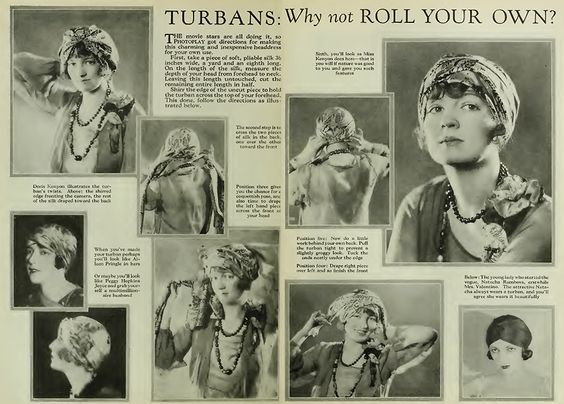Every year, I attend a 1920s themed event, and every year I either make or buy a flapper dress. I am using the word “flapper” loosely. I avoid the fringe flapper dress look because it is not accurate to the ’20s nor appropriate for a daytime event. When I make a flapper dress I look for simple drop waist dresses or slip dresses that I can trim and accessorize into something more authentic. Such was the case with a blue hanky hem dress I made a few years ago.
The first time I wore this dress, I thought it was great at home, but after seeing myself in some pictures I realized something was missing. The dress lacked the 1920s trim, embellishments, and accessories that would give it more personality. In short, it was a plain, simple 20s dress – nothing special, nothing unique, nothing to make it memorable. This is a common problem among costuming. We work so hard to find or make the perfect dress and maybe add a few basic accessories like a hat, shoes, and jewelry, but forget to look at our final outfits through 1920s eyes. Our modern eyes tend to favor simplicity. Designers/manufacturers can’t afford to add trim, so most new 1920s style dresses are also plain.
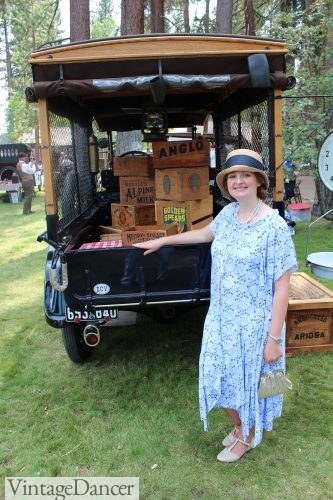
The first version of my Easy Frocks dress. Nice but too plain.

The Easy Frocks Pattern I used for my dress
The other thing that blinds us from 1920s vision is the missing bits and details long lost from genuine vintage garments. Look at nearly any vintage 1920s dress for sale and you probably will not find a belt, collar, tie, scarf, or coordinated dress clips that originally were sold with the dress. Trim was often removed and re-used on another dress so that surviving vintage dresses really are bare bones. Witness to Fashion wrote an excellent blog post showing what dresses look like before and after trim and accessories were added back on. It was her post that inspired me to breathe new life into my plain flapper dress and create a new, better, and dare I say much more accurate 1920s dress.
Once I started accessorizing my flapper dress, I couldn’t stop. I found so many different ways to use simple belts, scarves, flowers and jewelry that I now have 14 different dresses to choose from. It is amazing how one little accessory can dramatically change the personality of the costume.
Looking at vintage 1920s illustrations gave me all of these ideas on how to make my flapper dress special. Each is historically accurate and could have been included with my dress if it was sold in 1929!
(I handmade this dress from the 1929 Pretty Frocks the Easy Way booklet, which I recommend 100% more than the well known 1924 One Hour Dress booklet.)
On to the accessories!
Option 1. Add a Simple Belt
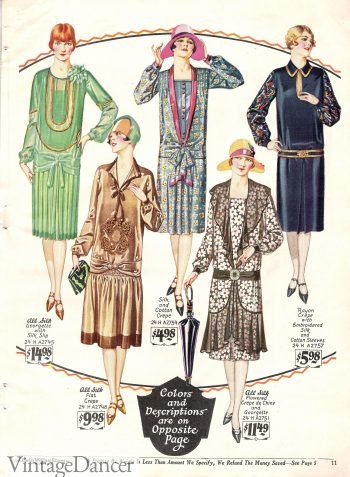
1927 dresses with a few drop waist belt styles
The first thing I did to my flapper dress was remove the sleeves. They may have looked better had I used a solid colored fabric like the pattern suggested. Removing rather than replacing them was all I had time to do, yet is historically accurate for a late 1920s summer dress.
The next thing I tried was to add a belt or sash around the drop waist/mid hip. I always say the easiest thing you can do to transform a modern dress into something 1920s is create a drop waist effect with a contrasting belt. I felt my dress desperately needed this detail.
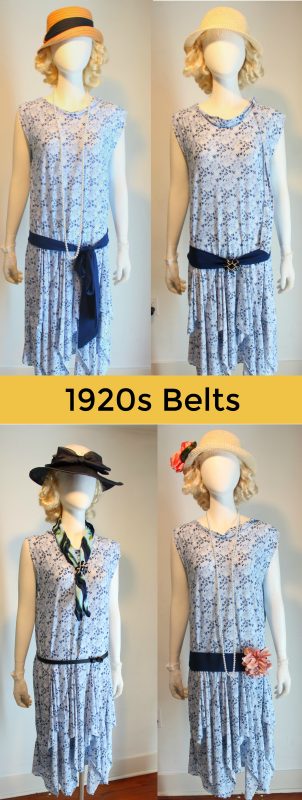
Add a drop waist belt or sash for instant 1920s style
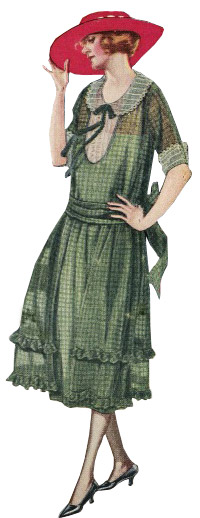
1922 dress with sash at the natural waist
1920s belts or sashes placed at the drop waist creates an instant 1920s look on almost any dress. Tie a sash with a bow (I used a blue skinny scarf as a sash), embellished with a large brooch, buckle or flower, or choose a thin buckle belt. All are accurate historical types of belts worn in the 1920s. However if your dress style is early twenties, 1918 to 1922, simply place the belt around your natural waist. The drop waist look encompassed most but not all of the 1920s. For all the women that tell me a drop waist is unflattering on them, I encourage you to go for an early ’20s fashion instead.
Option 2. Add Shoulder Detail
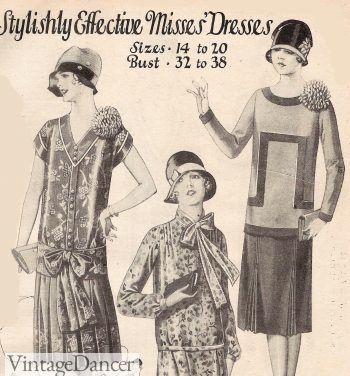
1927 dresses with flowers on the shoulder
In a decade where most dress trim was thin and vertical (to elongate the body), there was a fad for dresses that had movement. Hankey hems and pleated skirts added movement to the bottom of the dress, while oversized silk flowers and feathers created movement at the top of the dress. Adding one of these large, frilly flowers to the shoulder or down on the hip was a common dress decoration for both day and evening styles.
Flowers were often handmade from the same silk or chiffon dress material or from contrasting ribbon that was cut, feathered, and shaped into petals. Chrysanthemums were the most popular flower to emulate since they had many petals that floated as she walked. I have made ribbon flowers for a dress on a previous costume. You can learn how to make several styles in this book, or you can cheat like I did an purchase ready-made fabric flowers at the craft store. I would avoid floral arranging flowers because they are generally too stiff and too fake looking for a pretty afternoon frock.
Coordinate flowers or feathers to decorations on your hat for a unified look. Using a thin scarf draped down the shoulder also adds vertical lines and movement – a double win for a 1920s dress!

Large silk flowers, feathers, and bows were often added to shoulders and belts for a dramatic effect.
Option 3. Add a Long Neck Scarf
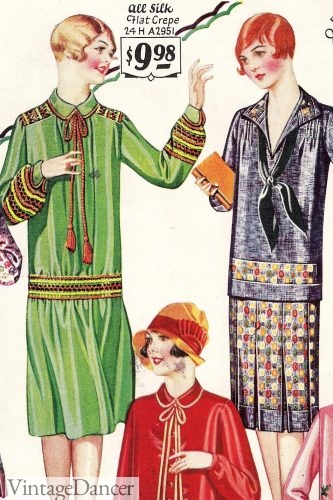
1927, long bows tied high and mid body
As you can see already, scarves are my favorite way to accessorize a 1920s dress. They easily act like belts, bows, and ribbon trim without being a permanent fixture on a dress. They are also very accurate to the 1920s. Most mid to late ’20s sporty afternoon dresses featured a long ribbon scarf loosely tied somewhere on the dress. Hanging from the neck was the most common treatment, although the placement of the knot or bow could hang in a number of different locations. I found my skinny scarves here.
If my dress had a collar, the bow would hang at the base of the collar. On my boat neck dress, the tie hangs from the neck freely. Notice how changing the placement of the bow or knot changes the look of the flapper dress. Which one do you think looks the most 1920s? I am partial to the yellow scarf placed below the chest. The color combination with the navy belt is very Art Deco.
One placement I didn’t photograph is a neck scarf tied to the side of the neck. These all hang straight down the center, but a side tie neck scarf is also very Roaring Twenties. See the costume from Downton Abbey below:
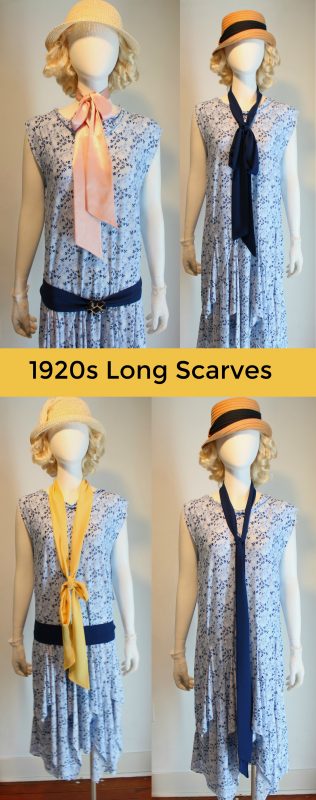
Long skinny scarves ads interesting detail to a dress without permanent trim.
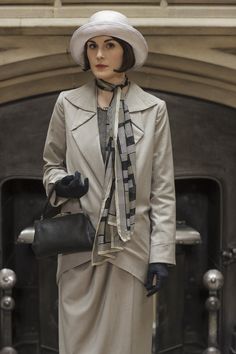
Lady Mary and a fashionable side tie scarf
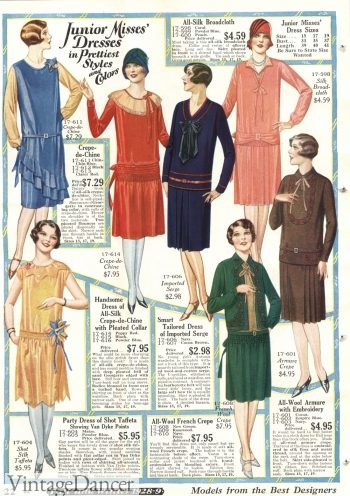
1928, more long ties and flower placements on these dresses.
Option 4. Wear a Wide Scarf
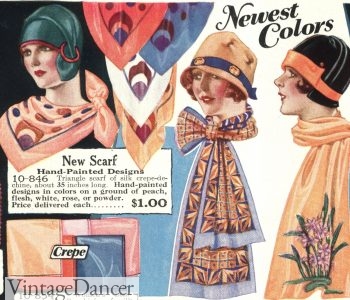
1928 ways to tie a scarf
Thankfully, skinny scarves are back in fashion this fall. A few months ago, they were impossible to find, and in its stead there were plenty of long and wide scarves, some with fringe. A fluffy silk or chiffon scarf can still be used to decorate a dress. The peach fringe scarf below was loosely tied in a half bow with the knot to one side. So ’20s!
The second scarf is your typical square scarf folded into a long rectangle, draped around the neck and secured with a brooch. The look is sporty and vastly different than most other uses for 1920s scarves. It was a common scarf tie on sailor themed middy blouses and collared dresses. I loved this look, although my photo doesn’t do it justice.
The next two scarves are made with an extra large square scarf. It needs to be large so that is can fit around your shoulders. I found a 1920s photograph where a woman tied her scarf in a simple fold over knot in the center and an illustration where the scarf was tied off center and secured with a brooch. I wouldn’t be surprised if I choose one of these looks for my dress this year.
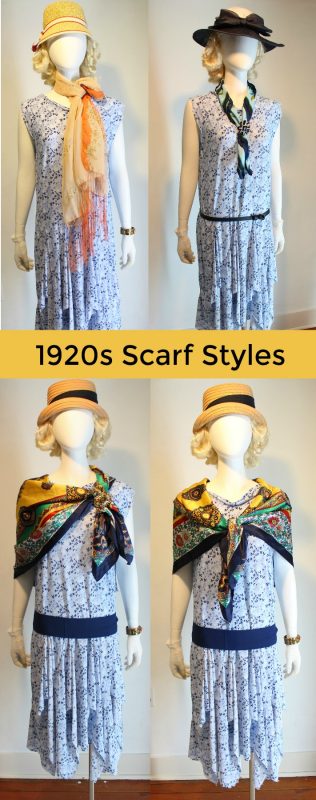
Different scarf types and placements create new looks on the same dress.
Scarves don’t need to be tied in fancy ways. Simply hanging a long fringe scarf around your neck is period correct for any era.
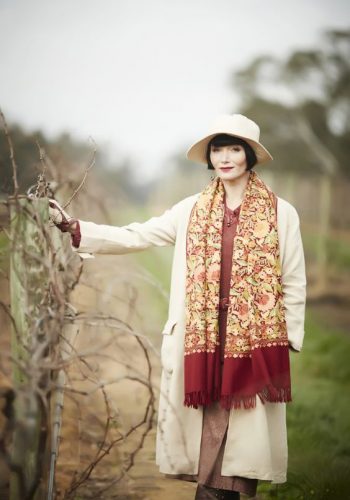
Miss Fisher wearing a wide fringe scarf casually hung from her neck
Option 5. Wear a 1920s Head Scarf
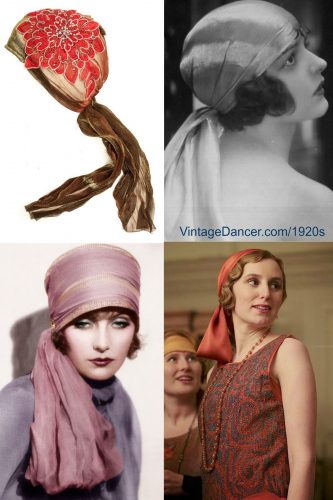
1920s head wraps with scarves. Upper right is a beautiful applique head scarf for sale here.
The fourth option is not a dress accessory. It is another way to utilize a scarf that will add character to your plain costume.
Women wore headscarves tied in many different ways throughout the 1920s. A long wide scarf could be wrapped around the head, knotted, and left draping at the back or side. A skinny scarf could be wrapped around the crown of the head and tied in a bow to one side. Others were tied around the crown like a headband without any bits to dangle. A few bohemian artist types tied it like a pirate, exposing the lower half of her bobbed hair. A scarf could also be tied up and around into a fashionable Turban hat.
I wish my mannequin was more cooperative with styling head scarfs so I could illustrate each option better. The pictures below should give you some more ideas.
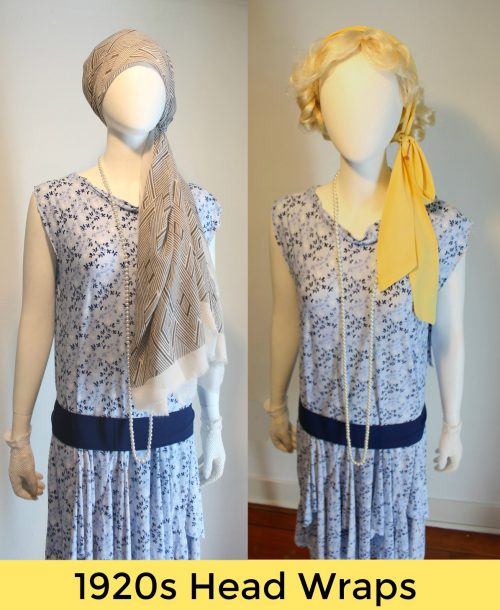
Two 1920s head wraps with large and skinny scarves
More 1920s Flapper Dress Accessory Tips
All of the above ideas were simple to create. In addition to these, you might also consider:
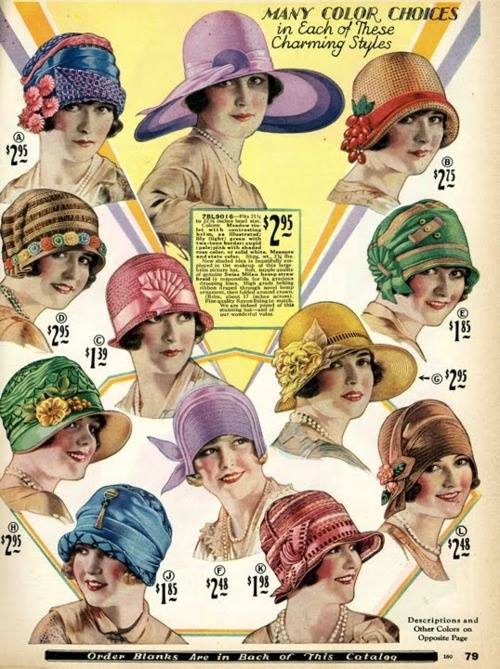
1928 hats for spring.
Adding jewelry. Long pearls or a bead necklace can easily dress up a plain dress. Be bold with your choices. Jewelry could be subtle if your dress was already well decorated, but if it is plain, a vibrant colored necklace will have a dramatic effect (and entice many nice compliments, too).
Wear a hat. Hats suffer the same issue as dresses. They are plain. A decorated 1920s hat usually has a nice matching bow or flower on one side, and that is it. Spend some time looking at vintage 1920s hats and see how fancy those decorations were. You could add applique, embroidery, silk flowers, and bows. You could reshape a felt or straw hat and shape a new brim into a fun jaunty angle (directions here). Give your hat some personality and coordinate one of the elements with something on your dress. Here are some good how to books on making hats you can buy and download. I also have one article on how I made simple hat decorations out of ribbon with directions for you to do the same.
Bring a purse. You need something to carry and help hide your cell phone or camera, car keys, makeup, and other modern necessities. I love to bring purses, fans, and gloves with me but usually remove them quickly. For that one perfect photo, you will want all the accessories on hand. You can get crafty and make a 1920s purse too.
Shoes and stockings. The final bit are a perfect pair of shoes you can walk in. I find heels difficult to wear on uneven ground and even more difficult to chase my kids in, so I’ll be wearing some comfortable flats this year. As for stockings, well, the best choices are solid colored silks or tan nudes with a natural colored seam. I can’t find any in maternity sizes, so I might be going bare legged. Gasp!
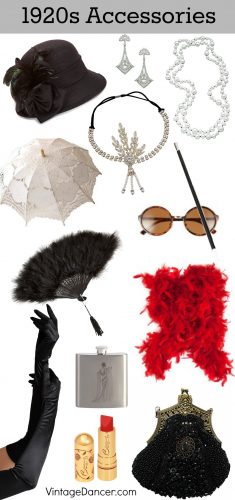
1920s accessories
How would you make a flapper dress more authentic?
Debbie Sessions has been teaching fashion history and helping people dress for vintage themed events since 2009. She has turned a hobby into VintageDancer.com with hundreds of well researched articles and hand picked links to vintage inspired clothing online. She aims to make dressing accurately (or not) an affordable option for all. Oh, and she dances too.
